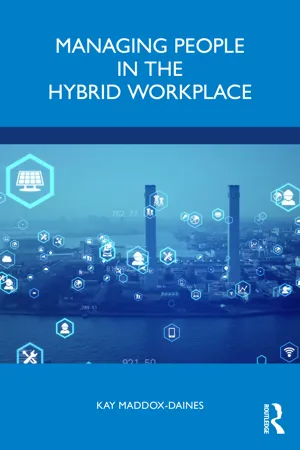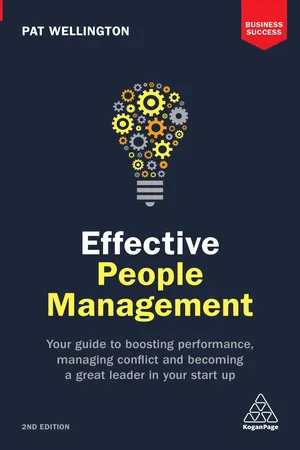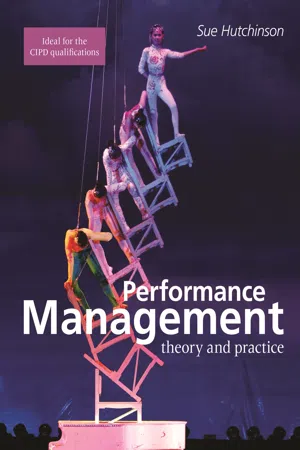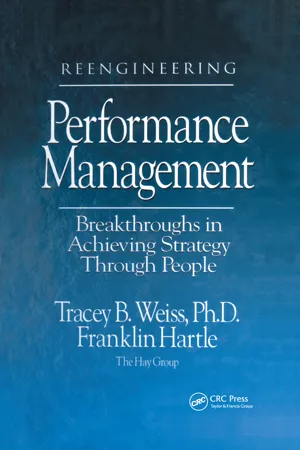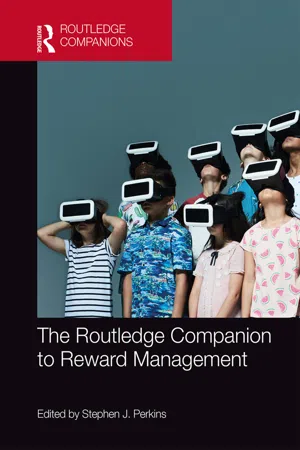Business
Rewarding Performance
Rewarding performance in business involves recognizing and incentivizing employees for their achievements and contributions to the organization. This can be done through various means such as bonuses, promotions, awards, or other forms of recognition. By rewarding performance, businesses can motivate employees to excel and align their efforts with the company's goals.
Written by Perlego with AI-assistance
Related key terms
11 Key excerpts on "Rewarding Performance"
- eBook - ePub
- Kay Maddox-Daines(Author)
- 2023(Publication Date)
- Routledge(Publisher)
Chapter 7 Rewarding talent in the virtual, hybrid and traditional workplace
DOI: 10.4324/9781003342984-8Introduction
Reward is an integral part of attracting and retaining talent. The reward strategy is vital in ensuring that the employer’s values are communicated and conveyed through its employees. This chapter provides an introduction to planning, implementing and evaluating reward systems in a range of organisational contexts. Ways of rewarding individual, team and organisational performance in a fair, reasonable and equitable way are explored along with gender and ethnicity pay gaps. An exploration of the guiding principles and reward philosophy is undertaken along with market intelligence in pay decisions. Base pay and variable pay are considered and a suite of incentive schemes designed for the contemporary organisation explored. Regional pay model challenges are noted in relation to contractual and fairness dimensions. The chapter reviews hybrid dilemmas such as how to balance the needs and wants of employees working anywhere.Defining reward
Reward management is defined by Armstrong (2010 : p.267) as ‘the strategies, policies and processes required to ensure that the value of people and the contribution they make to achieving organisation, departmental and team goals is recognised and rewarded’. Reward is generally understood as the total amount of financial and non-financial compensation or total remuneration provided to an employee in return for labour or service rendered at work. The CIPD (2021a - eBook - ePub
Effective People Management
Your Guide to Boosting Performance, Managing Conflict and Becoming a Great Leader in Your Start Up
- Pat Wellington(Author)
- 2017(Publication Date)
- Kogan Page(Publisher)
08Recognition and Rewarding Performance
Introduction
Organizational reward schemes need to be developed around key business drivers through team and individual development. So reward schemes need to place emphasis on moving away from protectionism to collaboration, from passing problems up the organization to solving them directly, from focusing on the number of units produced in a time period to meeting the needs of the customer. This is a shift from status to results. People observe what is being discussed, recognized and rewarded, what is punished, tolerated and also ignored. So it is up to you to make sure that recognition and reward is pertinent and underpins the environment you wish to create.Consider your own business. What kind of performance is rewarded and how? It’s obviously essential to choose rewards that are appropriate in your organization and possible within its structures. A good manager will reward their staff and build on their strengths. As higher performance levels are achieved, it is important to set new targets and new challenges. Reward systems will always need to be reviewed and updated and fresher and new approaches be found.The choice might be a celebration for the whole team. Maybe it would be a reward for service delivery – once a month. Some people want a financial incentive for profits and company gains. Everyone has a different expectation of reward and recognition. The common factor is that people want some kind of acknowledgement. Most businesses link rewards to key performance indicators (KPIs). Achieve them and get a reward. Achieve beyond expectations and get a bigger reward! Some companies are very creative with their rewards, for example giving people a chance to give back to the community during company time.Passage contains an image
Rewarding Performance
People often resist change for reasons that make good sense to them, even if those reasons don’t correspond to organizational goals. So it is crucial to recognize, reward, and celebrate accomplishments. - eBook - ePub
Introduction to Human Resource Management
A Guide to HR in Practice
- Charles Leatherbarrow, Janet Fletcher(Authors)
- 2018(Publication Date)
- CIPD - Kogan Page(Publisher)
A note says that goal-sharing is group bonuses based on group or team achievement of specific objectives. The source is C I P D 2017, p17.Reward schemes recognising organisational performance
Not all jobs within an organisation easily lend themselves to some form of individual or team-based performance measure. An alternative would be to base performance measures on how an organisation, as a whole entity, is performing. One option would be to pay part of the performance-related pay as rated by the outcome of an employee’s appraisal plus part paid based on how the organisation has performed. Even for a not-for-profit organisation, although it is more difficult to establish organisational performance measures, it is not impossible.Typical measures used to recognise business performance
- Profit sharing – annual cash bonuses, sometimes share options, paid in recognition of how the business has performed.1
- Gain sharing, where cash bonuses or share options are paid in recognition of incremental increases in business performance.
Activity 12.5
Table 12.2 is presented in part from the original CIPD (2017j) Reward Management 2017: Annual Survey Report. Access the full survey table and read the full analysis, which details the prevalence of different type of group reward schemes.As a group discussion, compare and contrast the incidence of the different mechanisms of group reward for: 1) public and private sector; 2) managerial and other employees. What conclusions can be drawn from the data and the narrative offered by the authors of the survey?Total reward
Previous discussion has centred on monetary reward, the exchange between labour and pay for services rendered. However, this is not by any means the full picture, especially when one considers the totality of the factors that impact upon motivation in the workplace.When considering the factors that motivate people, it is important to include the non-monetary rewards such as praise and career development; the reward equation must include both tangible and intangible rewards. According to Armstrong (2006), total reward consists of: - eBook - ePub
Performance Management
Theory and Practice
- Susan Hutchinson(Author)
- 2013(Publication Date)
- CIPD - Kogan Page(Publisher)
This chapter explores the different forms of performance-related rewards and their advantages and disadvantages, and uses the terms ‘variable pay’, ‘contingent pay’ and ‘incentive pay’ to also cover the concept of performance-related reward. As an introduction, the chapter begins by exploring the main categories and types of performance-related reward, the key trends and some of the general reasons for adopting such schemes, as well as some general criticisms. The chapter then examines one of the most popular forms of performance-related reward – individual performance-related pay – and the evidence for and against utilising such schemes. The rest of the chapter considers other types of schemes and their consequences.WHAT IS PERFORMANCE-RELATED REWARD?
The defining feature of this type of reward is that some or all of employee remuneration is dependent on some assessment of performance (Bryson et al, 2009), whether that be individual, team/group or organisational performance. When designing a performance-based reward scheme there are four key questions to consider (Shields, 2007; Perkins and White, 2011). These are:• What is being assessed?• Whose performance is being assessed?• Over what period of time is the performance being assessed?• What form does the contingent reward take?The first issue concerns the criteria for assessing performance: should it be based on behaviours or results, or on a combination of the two? Results-based approaches – such as piecework, commission, bonuses and stock options – are generally more straightforward to measure than behaviours, and are more appropriate where performance outcomes can be accurately specified, quantified and measured, such as in a sales environment. Behavioural measurements are more qualitative in nature and more likely to be found where outputs are less tangible, such as in the public sector and in research and development environments. Chapter 5 considered these alternative forms of measurement in more detail.As for whose performance is measured, it might be an individual, team, work group, workplace or organisation. Generally, research suggests that the closer the performance unit is to the employee, the more effective the outcome (Heywood and Jirjahn, 2006; Prendergast, 1999). An individual payment-by-results (PBR) scheme, involving a direct link between individual performance and pay, is likely to have the strongest incentive effects, whereas reward schemes linked to organisation-wide criteria tend to have the weakest incentive effects (Bryson et al, 2012). Systems linked to some form of collective performance are also vulnerable to ‘free-rider effects’ whereby less effective individuals take advantage of better-performing colleagues, or to ‘the Ringelmann effect’, named after Maximilien Ringelmann, who found that having group members work together on a task actually results in significantly less effort than when individual members work alone (Ringelmann, 1913). Group-wide schemes are also likely to have more ‘noise’ compared to individual-based schemes in that they will be more influenced by factors outside the control of the individual (Bryson et al - eBook - ePub
Human Resource Management
People and Organisations
- Stephen Taylor, Carol Woodhams(Authors)
- 2016(Publication Date)
- CIPD - Kogan Page(Publisher)
Extrinsic rewards by contrast include pay, status, non-essential training and even the working environment (that is, a more comfortable office). It is important to understand that organisations can use a combination of intrinsic and extrinsic rewards to motivate their employees, although there is no ‘one best way’ because the effectiveness of strategies depends to a large extent on organisational context and culture.This introductory section of the chapter has defined the concept of reward management and introduced basic principles that underpin it. In order to arrive at a greater comprehension of where reward management ‘sits’ in organisations it is important to understand the business context that it operates within.6.3 THE BUSINESS CONTEXT OF REWARD MANAGEMENT
The business context of reward management can be split into the following three broad areas:- the international context
- the national context
- the corporate context.
6.3.1 THE INTERNATIONAL CONTEXT
Global competition has demanded that organisations revise the ways in which they deliver services and products in order to produce the ‘exceptional’ performance that must be delivered to compete in the global marketplace. Taylor (2011) notes a number of trends affecting contemporary HR management, which extend to the area of reward management. These include: - eBook - ePub
- John Stredwick(Author)
- 2013(Publication Date)
- Routledge(Publisher)
In recent years, the expression ‘reward’ has started to replace ‘pay’ in the human resources vocabulary. It indicates a much broader approach, including elements of noncash awards, and presupposes that employees need to actually achieve something to receive their wages or salaries, unlike the more mechanistic attachment that pay indicates. Most of the developments in reward come from America and it is surprising that they still refer to the subject as ‘compensation’ with its connotation to the belief that work is unpleasant and should be avoided.In this chapter, we will start by examining the important components of designing a Total Reward system which is made up of the following sections:■ Determining the strategic elements of reward and how they link with other aspects of human resources and examining the more widely used concept of Total Reward.■ Summarising the component parts of the reward package .■ Designing basic pay structures through job evaluation systems, market tracking and competency approaches.■ Deciding which aspects of pay for performance schemes should be implemented and under which conditions.■ Constructing a benefits package that fits the needs of both the organisation and the employees.■ Considering special elements of pay practice that apply to executive pay.The next section will look at how employees can be motivated to achieve the organisational objective linked to strategic reward, which includes an analysis of the psychological contract .STRATEGIC ELEMENTS OF REWARDYou will recall from Chapter 1 that human resource strategy must be aligned with the business and policy objectives of the organisation. Commentators are quite clear on the part that reward strategy should play in this alignment process.Effective Reward strategies are … essential in today's knowledge-driven and human capital-constrained new economy in which people really are the key to an organisation's success. Any significant mismatch between the requirements on employees to implement the business's strategic goals and the behaviours that are rewarded, can spell corporate disaster. - eBook - ePub
Strategic People Management and Development
Theory and Practice
- Gary Rees, Ray French, Gary Rees, Raymond French(Authors)
- 2022(Publication Date)
- CIPD - Kogan Page(Publisher)
Companies may operate a system of forced ranking, or forced distribution, whereby groups of employees are compared against each other and ranked from best to worst, instead of being judged against independent performance standards. Although this approach is more common with appraising managers, it can be applied to any area of work. Employees who are placed in the lowest category (eg, the lowest 5 per cent) may be dismissed from the organization or given a fixed time to improve their current performance to the expected organizational standards. Conversely, the top-performing employees may be provided with significant learning opportunities, career growth and perhaps significant financial and personal rewards (Boyle, 2001).10.7.3 How can performance be improved?
Dependent upon the source(s) of the performance problem, the organisation needs to decide on the type and scope of problem intervention. There may need to be consideration of the macro-level issues affecting the broader organisational context, or attention given to micro-level, individual issues.Some of the techniques available include:- learning
- development
- training
- coaching and mentoring
- team-building
- culture change programmes
- reward schemes
- structure, process, systems, job redesign, etc
- management approach.
10.7.4 Strategic reward
According to the CIPD (2021v), strategic reward ‘takes a long-term approach to how an organisation’s reward policies and practices can balance and support the needs of both the organisation and its employees’. Total reward by contrast ‘covers all aspects of work that are valued by people, including elements such as development opportunities being rewarded fairly and flexible working, in addition to the pay and benefits package’.Perhaps a focus upon the types of offering within strategic reward systems may shine more light on what can be done in using rewards as a means of increasing performance. Thorpe and Holman (2000) discuss a range of interventions including time-based pay, skills and competence-based pay, performance related pay, team-based pay, gainsharing (where groups of employees and managers meet regularly to discuss and review performance and plan how to improve it, leading to enhanced company performance), profit sharing and employee shared ownership, flexible plans for pay and benefits and occupational pension schemes. Each of these offerings has an obvious link to both short, medium and long- term planning and career development for employees, with some of these potentially ruled out because they have too long a time frame in terms of binding arrangements. Alternatively, if an organisation is looking to reap the benefits of an employee’s labour over a relatively shorter period of time, many of these offerings could be adapted to a shorter time from if the organisation wishes to be flexible in making its reward packages attractive to the widest range of employees. - eBook - ePub
- Jay Galbraith, Diane Downey, Amy Kates(Authors)
- 2001(Publication Date)
- AMACOM(Publisher)
Organizations are relying more on team- and unit-based compensation than they have in the past. If your organization design assumes cooperation will be necessary because of the interdependence and complexity of the work, then the work should be motivated and rewarded through rewards that don't just focus on more than individual contributions. Team and unit incentives usually combine aspects of performance and skill-based pay.Performance Incentives. A performance goal is set for the team or business unit. It may be based on hard criteria, such as cost savings, output achieved, or deadlines met, or it may include some softer criteria, such as effective problem solving. When the goal is met, a bonus is given, either in the form of cash, stock, or noncash rewards. When it is linked to a gain-sharing or profit-sharing plan, the amount is tied to the overall financial performance of the unit.Skill-Based Pay. Teams can be rewarded for the collective skills they accumulate. The team is not rewarded until all team members reach a certain level, in order to encourage the more skilled employees to help others achieve competence. It is most commonly applied in team settings where the tasks of the team are specific and measurable and where there is a desire to make the team more flexible and autonomous by increasing the skills of all team members. As each team member learns and applies the skills that are needed by the team overall, that person's pay is increased. Team members cross-train in the work of others in order to lessen the impact of absenteeism on productivity. People are also rewarded for developing management skills. As these responsibilities are moved to the team, the organization can reduce the number of managers needed.Rewards based on collective effort and outcomes have some potential hazards.Distinguishing Which Organizational Level to Reward. - Tracey Weiss, Franklin Hartle(Authors)
- 2023(Publication Date)
- CRC Press(Publisher)
All of these stories represent radical departures from the status quo. All used a blend of “how” and “what” measures. All sought to reach below the tip of the iceberg and appeal to the qualities that make people want, and need, to excel. All were seeking to tap a source of energy they would need to drive their strategies—the engine in reengineering. In short, these leaders reasoned that they would have to create a high level of motivation if they were going to ask for new behaviors and raise the bar on performance. They all sought—and found—the last piece of the performance puzzle: a way to reward human performance that truly adds value to the organization.It’s safe to assume nobody will perform without some kind of reward, monetary or otherwise. The key is to harness this source of motivation and use it to pull the organization forward. A well-designed performance management plan that is aligned with rewards is an excellent tool for managing that balance between intrinsic and extrinsic rewards, which together are the source of motivation and the key answer to the “why” of performance. In fact, we’ve found that rewards work best when they function in sync with a performance management program that reaches the bottom of the iceberg. And pay is only part of the picture.In his book Human Motivation, David McClelland points out that money is misleadingly concrete as an incentive. He says psychologists use it in experiments—and, we might add, businesses use it in practice—because it is easier to manipulate than other incentives like personal development opportunity or recognition. In a sense, we have all been trained to value money as the symbol of success. But McClelland demonstrates that money always takes on the meaning of the particular motivational situation in which it is employed as an incentive.1 To illustrate, he describes an experiment where a professor offered students $2.50 if they could complete a project faster than average performers, who would receive half that amount. While the incentive did appear to make the students work harder, McClelland argues that the larger prize may have lent prestige to faster performance, thus raising the students’ desire to please the professor. From our business experience, we can add that a professor (manager) who commands no respect from his or her students (employees) might even be de-motivating students by insulting them with a trivial reward.McClelland shed light on the elusive relationship between pay and performance. Even substantial raises and bonuses for top performance may de-motivate in the long term, especially if they are not supported by a fair, well-reasoned, and widely understood system of performance management. Money alone is not sufficient to foster an ongoing, lasting productivity boost. Often, an employee’s primary desire is to feel part of the organization and to be recognized for the work he or she does. People are motivated to their core by a higher cause. In this sense, performance management can make the difference between pay being a motivator and its becoming a neutral or negative influence. Rewards work best as a strategic tool when they are tied to a well-designed performance management process that is, in turn, aligned with the organization’s culture. Pay is not a panacea. We need to look at it, as McClelland pointed out, in the context of the motivational situation in which it is employed.- eBook - ePub
- Stephen J. Perkins(Author)
- 2018(Publication Date)
- Routledge(Publisher)
Figure 7.4 . As well as a conceptual and research framework, it is designed to be a practical process so as to encourage practitioners to use the model. Evaluating the effectiveness of reward practices has to be a key component of any strategic reward approach. But this needs to be a continuous and multidirectional process, linking reward goals and intended outcomes, as well as reward programme designs intended to deliver these outcomes, with ongoing evaluation, monitoring and adjustment, based not just on performance results but also line management and employee feedback.Figure 7.4 The process model for evidence-based reward managementSource: Armstrong, Brown and Reilly (2010).Delivering the outcomes: total rewards and its relationship with reward strategyA CIPD study carried out with an Aston University team amongst a sample of 15 service sector organizations found that the five highest performers made greater use of bonuses and non-financial recognition than the remainder. In similar fashion to Guest (2003), however, the study found that a variety of other management practices and HR policies – regarding career development, employee involvement, performance management and work–life balance – were vital in creating the supportive context for employees to commit to serve the customer, and created a strong sense that the entire organization “practices what it preaches” (Brown and West 2005). Anyone interested in using rewards proactively to help reinforce the delivery of their business strategy therefore needs to pay at least as much attention to non-financial as to financial rewards.However, following the onset of economic recession in 2008, evidence has been emerging that more and more UK organizations were not ‘practising what they preach’ in respect of total rewards. The familiar say/do, policy/practice, rhetoric/reality gap (Bevan 2006) in reward strategy appeared to be particularly evident in respect of total rewards (Brown 2012, 2014). While attractive total rewards language remained on company recruitment sites and intranets, 40% of UK employers froze pay in 2009/10 and many reduced employee pensions benefits, as well as placing increasing numbers of staff on significantly inferior ‘zero hours’ contracts. This low-investment, total rewards rhetoric, with its uniform flexible benefits plans, does no more to support the delivery of business strategy in practice than the totally pay-focused approach of the early reward strategy proponents (Brown 2014). It can also be seen to have played a role in the launch of the current UK government’s agenda of what the prime minister called a “fairer economy that works for everyone” (May 2016). - eBook - ePub
Built to Change
How to Achieve Sustained Organizational Effectiveness
- Edward E. Lawler, Christopher G. Worley(Authors)
- 2011(Publication Date)
- Jossey-Bass(Publisher)
Second, if a line of sight can be established between what an individual does and the performance of the entire business or business unit, then basing part or all of any bonus payments on organizational performance makes sense. In general, a bonus plan based on the performance of an entire business has many advantages. It both motivates individual performance and causes people to integrate themselves into a high-performing unit—a key step in creating the kind of virtuous spiral that every organization would like to have. It also can stimulate change if an organization’s performance drops. Individuals get smaller bonuses and, as a result, want to know what happened and what needs to change.In the best of all worlds, business-based bonus plans lead to pay well above market rates because the organization’s performance is above average. This occurs as a result of the plan’s effectively motivating everyone’s performance as well as attracting and retaining top-performing people—a true virtuous spiral situation.Third, operating an effective business-based bonus plan requires that people be thoroughly educated in the bonus plan. They need to know how their performance is measured, how their behavior affects the entire organization’s performance, how the performance of the business is measured, and how they will be rewarded if different parts of the organization perform at different levels. When everyone’s bonuses are determined, employees need to see how the decisions were made and what the amounts are.One final point about bonus systems: often the best way to reward individual behavior and organizational performance is to tie the size of the bonus pool for individual rewards to the performance of a business unit or the total organization. The performance metrics that are used at the organizational level can be traditional accounting measures, operational measures, or a change target. The advantage of creating a bonus pool based on organizational performance measures is that it reinforces both individual and collective performance. And, as we mentioned earlier, it can also help focus the attention of individuals on the external environment and on how the company is performing relative to that market.Profit Sharing
Profit sharing is the oldest and most commonly used bonus-based approach to rewarding organizational performance. In 2002, fully 69 percent of the Fortune 1000 companies operated profit-sharing plans.5
Index pages curate the most relevant extracts from our library of academic textbooks. They’ve been created using an in-house natural language model (NLM), each adding context and meaning to key research topics.
